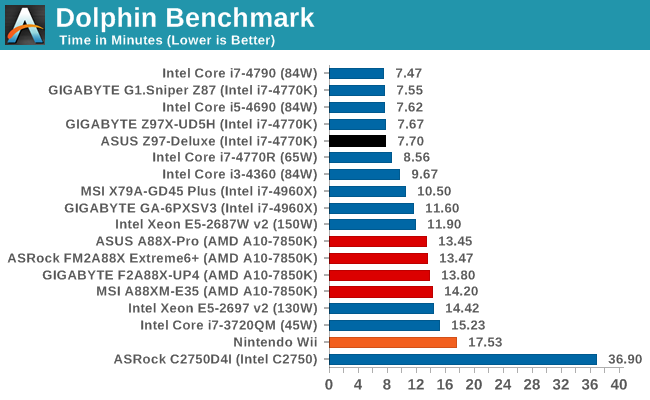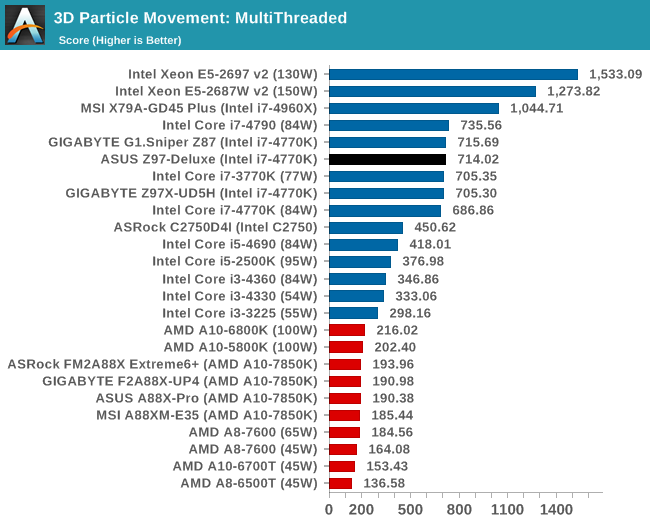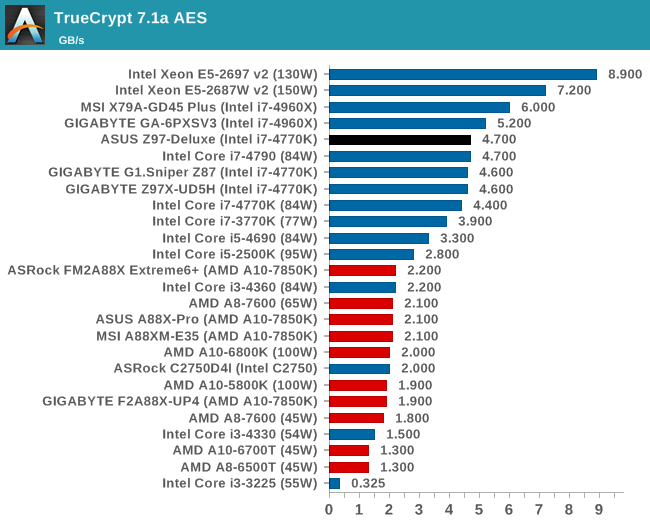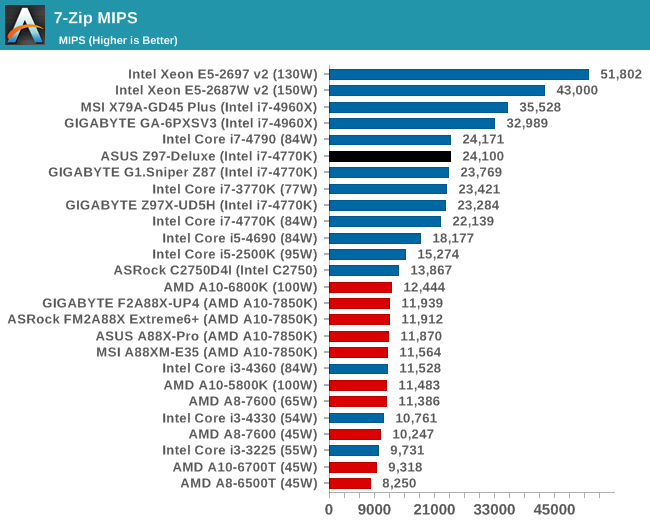ASUS Z97-DELUXE (NFC & WLC) Review: With Two Thunderbolt 2 Too
by Ian Cutress on May 16, 2014 11:00 AM EST- Posted in
- Motherboards
- Intel
- Asus
- NFC
- 802.11ac
- Thunderbolt 2
- Z97
- Wireless Charging
Scientific and Synthetic Benchmarks
2D to 3D Rendering –Agisoft PhotoScan v1.0: link
Agisoft Photoscan creates 3D models from 2D images, a process which is very computationally expensive. The algorithm is split into four distinct phases, and different phases of the model reconstruction require either fast memory, fast IPC, more cores, or even OpenCL compute devices to hand. Agisoft supplied us with a special version of the software to script the process, where we take 50 images of a stately home and convert it into a medium quality model. This benchmark typically takes around 15-20 minutes on a high end PC on the CPU alone, with GPUs reducing the time.

Console Emulation –Dolphin Benchmark: link
At the start of 2014 I was emailed with a link to a new emulation benchmark based on the Dolphin Emulator. The issue with emulators tends to be two-fold: game licensing and raw CPU power required for the emulation. As a result, many emulators are often bound by single thread CPU performance, and general reports tended to suggest that Haswell provided a significant post to emulator performance. This benchmark runs a Wii program that raytraces a complex 3D scene inside the Dolphin Wii emulator. Performance on this benchmark is a good proxy of the speed of Dolphin CPU emulation, which is an intensive single core task using most aspects of a CPU. Results are given in minutes, where the Wii itself scores 17.53; meaning that anything above this is faster than an actual Wii for processing Wii code, albeit emulated.

Point Calculations – 3D Movement Algorithm Test: link
3DPM is a self-penned benchmark, taking basic 3D movement algorithms used in Brownian Motion simulations and testing them for speed. High floating point performance, MHz and IPC wins in the single thread version, whereas the multithread version has to handle the threads and loves more cores.


Encryption –TrueCrypt v0.7.1a: link
TrueCrypt is an off the shelf open source encryption tool for files and folders. For our test we run the benchmark mode using a 1GB buffer and take the mean result from AES encryption.

Synthetic – 7-Zip 9.2: link
As an open source compression tool, 7-Zip is a popular tool for making sets of files easier to handle and transfer. The software offers up its own benchmark, to which we report the result.











45 Comments
View All Comments
aron9621 - Saturday, May 17, 2014 - link
The Z87 Deluxe Quad uses a PLX switch (a PEX8608 I believe) for the PCI Express 2.0 lanes coming from the chipset. It's a shame given the price category the Z97 Deluxe doesn't do the same and limits the simultaneous usage of the SATA Express/M2/Thunderbolt ports.UltraWide - Friday, May 16, 2014 - link
Fan curve control from the BIOS, this is worth the GOLD color! WOW I have been waiting for such a feature for the past 10 years.ASUS you got my money and vote. :thumbsup: x 2
OuchIAteMyself - Friday, May 16, 2014 - link
It has been worth it for me to pay more for these premium motherboards. I'm using a P5B Deluxe bought in 2006 to post this comment and it's still going strong. ASUS even released a BIOS update that allowed me to upgrade to a Q9550 processor which is fairly modern. I'll buy ASUS again when I build a new system within the year.pt2501 - Friday, May 16, 2014 - link
LOL I had that the P5B Deluxe for 5 years and thought it was simple, powerful, and rock solid. For the price it offered up the best overclocking and when I built it in late 2006 I paired it with the lowest of the then new core 2 duo (1.6 GHz model). It received a plethora of updates that allowed it to later upgrade to use the top the Cord 2 Duos/Quad cores. I later put in a 3.0 Ghz duo core with the added cache for better performance and maxed out the Ram capacity without any loss of stability. The board never failed I eventually recycled it for lack of anyone wanting a desktop. Now i run an older P8Z68-V Pro/Gen3 with an i5 2500K. The support from Asus for all my boards has been outstanding.I felt like I ponied up alot more cash for this board but the difference in all the features more than pays for itself over time. UEFI, 4 way SLI/Crossfire/TPU/EPU: you can literally do anything with this board and I have never felt like I was missing out on anything.
Most likely unless Asus starts making garbage, if you buy one of their boards my experience has been that you can use it until the subsequent technology becomes completely obsolete.
AssBall - Sunday, May 18, 2014 - link
The DELUXE set from Asus has always been top notch and rock solid. My first build ever was Lots of overclocking and tweaking options. The power delivery is some of the best in the industry, IMO. The new UEFI BIOS's are sweet to work with. Now they also put some decent integrated sound processors on the boards too, which adds a ton of value in my book.Their Pro stuff is really good too if you want a simple overclock system or a 24/7 workstation. The only thing better than an ASUS board is a new ASUS board, heh.
jibz - Friday, May 16, 2014 - link
Nice review. I like the fact that you added audio benchmarks. What I'd like to see included are the numbers for a good add-on card, if only to establish some kind of upper echelon. I understand that it's not fair to compare a 300$ sounds card to the one included on a 300$ motherboard, but it'd help to put the numbers in perspective.cjs150 - Friday, May 16, 2014 - link
Lovely looking board but someone needs their head examined on the storage.This is a top end board it should be capable of having a big GPU, m2 drive as boot drive and ultra fast storage via thunderbolt
xeizo - Friday, May 16, 2014 - link
You could say I use only Asus DeLuxe mobos as I have both the P5Q-DeLuxe and the P8Z68-DeLuxe/G3 currently up and running ;-)The P5Q-DeLuxe has been running since 2008 and 24/7 for the last three years(web/music/movie/nas-server). The P8Z68 is the gaming/development/music production/workstation and performs admirably with dual SSD:s, 16GB RAM and a single GTX770(as I only use 1080P). Very happy with these mobos, 4xUSB3 and 4xSATA6 is very usable on the P8Z68, good for being from 2011 ... It also has no problems remaining stable above 5GHz on water with 8x100% load like forever ....
However, next mobo will be made for Haswell-E with ZX99(?), Z97 is too much of a sidegrade and more cores is good to have when compiling. Higher clocked Xeons are only damned expensive :(
wwwcd - Friday, May 16, 2014 - link
Board FeaturesASUS Z97-Deluxe (NFC + WFC)
...........
Chipset Intel Z87
...........
WoW :D
Ian Cutress - Friday, May 16, 2014 - link
AHA! Re-using old table templates, thanks for the catch :D